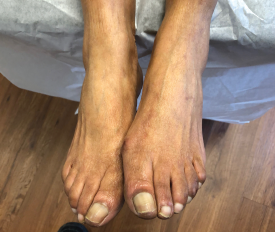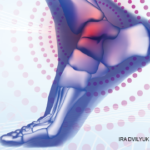
Dr. Smith
In addition to looking at limb length, evaluating movement and flexibility is an important element of the physical exam, says Craig A. Smith, PT, DPT, Smith Performance Center, Tucson, Ariz. An abnormal gait pattern can be caused by pain, joint effusion or quadriceps weakness, he says, and it’s important to differentiate between these factors before treating.
“If there are joint limitations, you can get what will look like a leg length discrepancy that’s not real,” Dr. Smith says. “That’s a perfect opportunity to try to get the motion back,” potentially by referring the patient to a physical therapist or orthopedist, he says. “But if [the patient has] a true leg length discrepancy and they also have something that’s painful occurring, my recommendation is to … do a gait analysis.”
Dr. Smith looks at five distinct elements during a gait analysis, which helps him identify the underlying issue. For example, a patient with joint effusion doesn’t go through the “normal flexion–extension cycles that occur during the gait cycle,” he says, and the
patient will often “present in the gait analysis like they have a functionally longer leg on one side because they won’t be fully changing their knee like they normally do.” Especially if the patient has been experiencing pain for a long time, they may be compensating for swelling that effectively shut off their quadriceps, so it looks like they have one leg that is long and stiff because they fully extend their knee joint when their heel hits the ground. Alternately, the leg may look functionally shorter if the patient is unable to fully extend their knee because of pain.
In addition to physical examinations, confirming LLD using radiographic imaging is considered the gold standard.1 Other technologies, including ultrasound, laser-
ultrasound and 3-D imaging, may also be used for precision.7–9
Prognosis & Treatment

A visual examination in the physician’s office demonstrates a leg length discrepancy in a patient with unilateral osteoarthritis.
Interventions used to treat LLD vary, depending on the patient and the severity of the discrepancy, and can range from no intervention all the way to surgery. For patients who are experiencing unilateral OA pain related to a clinically significant discrepancy in leg length, treatments may include pharmaceuticals for pain management, physical therapy to address muscle weakness or abnormal gait, or shoe inserts or lifts. By detecting the discrepancy and treating it, further damage to the joint may be prevented.
Lift therapy should be implemented gradually and should be used more conservatively for older patients.4 “If someone has 5 mm or 10 mm of leg length inequality, then generally we would bolster the shorter side with a shoe lift,” Dr. Segal says. He notes that it’s important not to treat more than half the difference—for example, if a patient has an 8 mm difference, the lift would correct 4 mm of it. This is to avoid additional issues such as low-back pain.

